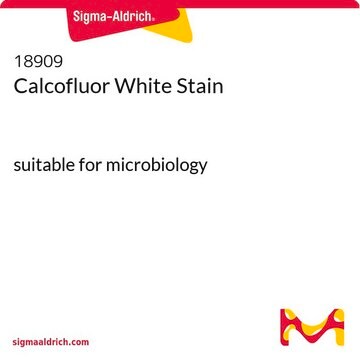910090
Fluorescent Brightener 28 disodium salt solution
used as a stain and brightening agent
Sinónimos:
Fluostain I, Calcofluor White LRP, Calcofluor White ST, Calcofluor white M2R, Tinopal LPW
About This Item
Productos recomendados
formulario
liquid
concentración
25% in water
cadena SMILES
[Na+].[Na+].OCCN(CCO)c1nc(Nc2ccccc2)nc(Nc3ccc(\C=C\c4ccc(Nc5nc(Nc6ccccc6)nc(n5)N(CCO)CCO)cc4S([O-])(=O)=O)c(c3)S([O-])(=O)=O)n1
¿Está buscando productos similares? Visita Guía de comparación de productos
Descripción general
Aplicación
- Fluorescent Brightener 28 is used in microscopy as fluorochromes, especially to visualize plant tissues by binding to cellulose.
- It is used in microbiology for staining pathogenic fungi, fungal cell walls, Candida albicans biofilms, for the automated counting of bacteria and spores, and as a viability stain.
- It is a rapid method for the detection of many yeasts and pathogenic fungi such as Microsporidium, Acanthamoeba, Pneumocystis, Naegleria, and Balamuthia species.
- It is used industrially as a fluorescent brightening agent for cellulose and polyamide fabrics, paper, detergents, and soaps.
- It has been used in the identification and study of the structure and biosynthesis of chitin from the freshwater sponge Spongilla lacustris, and to elucidate the location of chitin in skeletal structures.
Acciones bioquímicas o fisiológicas
Características y beneficios
- Facilitates rapid detection of many pathogenic yeasts and fungi.
- As a brightening agent, its addition can offset the tendency of white materials to yellow with age.
Código de clase de almacenamiento
12 - Non Combustible Liquids
Clase de riesgo para el agua (WGK)
WGK 1
Punto de inflamabilidad (°F)
Not applicable
Punto de inflamabilidad (°C)
Not applicable
Choose from one of the most recent versions:
Certificados de análisis (COA)
Don't see the Right Version?
If you require a particular version, you can look up a specific certificate by the Lot or Batch number.
¿Ya tiene este producto?
Encuentre la documentación para los productos que ha comprado recientemente en la Biblioteca de documentos.
Nuestro equipo de científicos tiene experiencia en todas las áreas de investigación: Ciencias de la vida, Ciencia de los materiales, Síntesis química, Cromatografía, Analítica y muchas otras.
Póngase en contacto con el Servicio técnico








